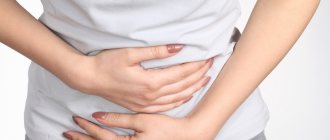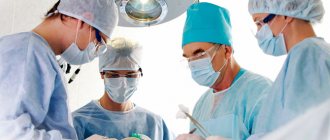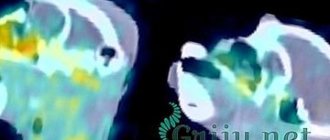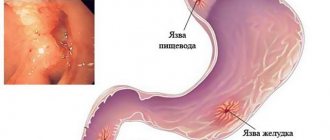Appendicitis – a serious condition, often acute in nature, associated with inflammation of the appendix. Some patients experience a chronic course of the pathology. Without treatment, the disease can lead to death, to avoid which it is necessary to clearly know the signs and methods of treating the inflammatory process.
Appendicitis is one of the most commonly diagnosed pathological conditions in the abdominal cavity, due to which approximately 90% of operations are performed in this area. The disorder occurs equally often in men and women; age also does not matter much. In most cases, the disease occurs in patients under 30 years of age.
To identify pathology, you need to know where the inflammation is located. It forms in the appendix, which is a vestigial appendage in a small area of the cecum. The process is a small elongated tube. The walls of the appendix consist of four layers: mucous, submucosal, muscular and serous. Taking into account the age of the patient and the characteristics of his body, the process is 5-15 cm long and no more than 10 mm thick.
Attention! Despite the fact that the appendix is a vestigial segment, it has been proven that it is necessary for maintaining proper intestinal microflora.
Classification
Most patients know only the acute stage of appendicitis, but a small number of patients develop the chronic stage. It is also located in the area of the appendix and is characterized by its own symptoms. In the acute form of the inflammatory process, experts distinguish between catarrhal and destructive course of the disease.
- The catarrhal or simple form is different in that when it occurs, problems appear in the form of impaired blood circulation and lymph flow in the appendix. Gradually, a large amount of pus forms in the mucous layer. The serous membrane fills with blood and greatly stretches.
- If help is not provided within 24 hours, a destructive form develops. In this state, pus begins to ooze from the lumen of the appendix, and the organ swells and stretches more and more. Multiple abscesses gradually form. Necrosis and tissue rupture subsequently develop, leading to peritonitis. In this condition, pus leaks into the abdominal cavity, which often leads to death due to massive intoxication and inflammation of the organs.
In the chronic course of appendicitis, primary and secondary stages are distinguished. In the first option, patients have never suffered from acute inflammation in the appendix, and the disease appears as a result of proliferation or narrowing of the walls. Because of this, pus, undigested food particles, and liquid may accumulate, which will cause discomfort.
In the second case, the chronic stage is provoked after surgery to remove the appendix or due to multiple repetitions of attacks that did not require removal of the appendix.
Appendicitis in this form rarely gives clear symptoms and is more often similar to ordinary indigestion or problems in other abdominal organs. Only a competent surgeon can suspect a violation. But almost always, with a chronic course of the disease, patients may suffer throughout their lives due to discomfort and not understand its true nature.
About the disease
The pathology occurs in acute or chronic form. The second option is rare. Treatment of an inflamed appendix with conservative methods is carried out only in exceptional situations when surgery is not possible.
Acute appendicitis is classified as the most common disease of the peritoneal organs, requiring immediate surgical intervention.
Acute abdomen syndrome
Intense pain, nausea, repeated vomiting and abdominal muscle tension are the most expressive signs of a crisis state.
But it is precisely these symptoms, accompanied in most cases by an elevated temperature, that are characteristic of most other gastrointestinal diseases. In addition, in humans, the appendix is located in a variety of areas of the abdominal cavity. This complicates the situation.
To make a diagnosis, a doctor must consider many factors:
- age and gender of the patient;
- exclusion of diseases associated with urological, infectious, gynecological pathologies;
- anatomical features of the location of the organ.
The inflammatory process, which in almost all cases requires surgical treatment - appendectomy, is most often observed in women of childbearing age.
Men suffer from this pathology less often. In adolescence and young adulthood, acute appendicitis occurs more often in boys and young men.
What diseases are appendicitis differentiated from?
Signs that indicate the possibility of the pathology in question are also characteristic of such conditions as:
- poisoning;
- infectious diseases;
- inflammatory processes in the gastrointestinal tract;
- diseases associated with diseases of the genital organs in men and women;
- infectious pathologies of the bladder, kidneys;
- intestinal obstruction.
This list can be continued with other diseases developing in the peritoneal area.
Possible dangers
Appendicitis is an insidious disease.
The following consequences should be noted:
- A pathological process accompanied by inflammation of not only the appendix, but also adjacent areas, provokes intestinal obstruction.
- In particularly serious cases, blood poisoning occurs.
- The lack of timely treatment leads to serious complications, the most dangerous of which is peritonitis, which is a consequence of rupture of the appendix.
The last complication, often leading to death, becomes possible when the symptoms of the disease are ignored.
Location of the organ
The appendix is located at the intersection of two conventional lines: horizontal (at the level of the navel along the circumference of the abdomen) and vertical (from the right chest down).
The most typical place for the process is the iliac zone. It is located slightly to the side of the vertical line with an offset to the right. That is why, in the acute form of the pathology, the reaction of the right leg when palpating the same side of the abdomen is checked.
But this arrangement is not always observed. The frequently occurring atypical localization is explained by the presence of a long mesentery, which facilitates the possibility of displacement of the process attached to the cecum at only one end. The other may be in close proximity to the large intestine.
Changing the usual location of an organ does not affect a person’s life in any way, but is important for the surgeon if it is necessary to perform an operation.
Possible localization options
An atypical position of the appendix is observed in the following areas of the abdomen:
- in the pelvic area;
- behind the cecum;
- behind the peritoneum;
- under the liver;
- near the ascending colon.
Such deviations from the normal location occur due to a defect associated with an atypical rotation of the midgut, when it is somewhat incomplete . In this case, the vermiform appendix can be freely placed in the abdominal cavity. The most surprising option is its location in the left hypochondrium.
Regardless of which side appendicitis develops, pain during exacerbation is observed in the right iliac zone. Symptoms such as skin hyperemia and muscle tension also appear there. Only in the process of worsening the inflammatory process do they make themselves known in the area where the process is actually located.
Features of the course of the disease
Classic symptoms (fever and pain) of acute appendicitis are observed in all cases.
Other symptoms appear depending on how the process is located:
- With a retrocecal location of the appendix (the appendix is pressed against the kidney, ureter or lumbar muscles), which is the most common example of an atypical location of the organ, acute abdomen syndrome does not appear immediately.
- If the appendix is located near the ureter, its inflammation is accompanied by intense pain, radiating to the genitals. Accompanied by a frequent urge to urinate.
- The retroperitoneal location of the appendix makes diagnosis most difficult, since the appendix is covered by the parietal peritoneum and the cecum. The predominant symptom is intoxication. In this case, appendicitis is indicated by pain in the groin area and muscle resistance during passive alignment of the right lower limb.
A left-sided appendix is very rare and is accompanied by the reverse position of organs such as the heart, liver, sigmoid colon, or excessive mobility of the right part of the colon.
The clinical course of inflammation in this case differs only in the mirror manifestation of all signs. If it was previously established that the heart is on the right side and the liver is on the left, then the appendix will be on the left side.
Reasons for appearance
Most often, the disorder occurs against the background of exposure to E. coli, staphylococcus, streptococcus and other pathogenic bacteria.
They enter the mucous membrane of the appendix through its lumen from the cecum and begin to actively multiply. But the symptoms of exposure to pathogens begin to appear especially clearly and quickly when food stagnates in the rudiment, when it is bent, feces enters or there are problems in the blood circulation. All this leads to increased pressure in the appendix, which only worsens the general condition. Bacteria begin to actively penetrate the mucous membrane and produce pus.
There is an opinion that the patient’s diet also plays a large role in the occurrence of the disorder. If a patient is addicted to meat products and suffers from systematic constipation, an ideal protein environment for the proliferation of bacteria is formed in the rudiment. The same processes can lead to displacement and bending of the organ, especially in the absence of prolonged bowel movements
Any inflammatory processes in the gastrointestinal tract can cause the formation of appendicitis. Most often, inflammation appears after amebiosis, intestinal tuberculosis and typhoid fever.
Pregnant women are at risk for the disease. Due to the growing abdomen and uterus, there is a strong displacement of all parts of the intestine, including the appendix. This can lead to constipation, congestion, problems with the immune system and poor circulation to organs. Therefore, women need to eat a sufficient amount of plant foods, combining them with protein foods. In case of constipation, it is recommended to drink compotes of prunes and raisins.
How does appendicitis hurt during inflammation?
How does appendicitis hurt in case of inflammation? A characteristic feature of inflammation is that the pain attack disappears if the person takes the so-called “embryo” position: lies on his side, bends his legs at the knees and pulls them towards the body.
Also, with inflammation of the appendix, other signs of the disease may occur:
- Attacks of nausea, which can often be accompanied by vomiting. At the same time, vomiting does not bring long-awaited relief.
- Bloating, increased gas production.
- Inflammation of the appendix may be accompanied by bowel disorders - constipation or diarrhea.
- Increased urination.
- Slight increase in body temperature.
In the absence of proper treatment, the disease may be accompanied by the appearance of a dense brown coating on the surface of the tongue. As a rule, this most often occurs on the third day from the moment the appendix hurts.
Symptoms
Everyone should know how to determine the disorder, since the disease quickly leads to inflammation and rupture of the rudiment, which becomes the cause of peritonitis. The disease is always characterized by acute pain. Pain from appendicitis is most often localized in the iliac region on the right side.
At the beginning of its formation, the discomfort is vague in nature and may be felt more in the navel or stomach area. But after 1-4 hours it moves to the right and the perineal area, often pain is felt in the lower back and pubis.
But it is important to find out not only how appendicitis hurts, since in a small percentage of patients the discomfort is quite bearable. If the pain is not fully felt and is bearable, the disease is determined by indirect signs:
- increased pain after sneezing, coughing and laughing;
- reduction of discomfort in a horizontal position on the right side;
- the appearance of nausea and vomiting;
- lack of bowel movements and severe gas formation;
- some patients develop severe diarrhea;
- the temperature rises to subfebrile, sometimes to critical at +40;
- when raising the right leg, significant discomfort is felt in the right side;
- tachycardia develops, heart beats can reach 110 per minute;
- the general condition is characterized by weakness, apathy appears, and sometimes disorientation appears.
Due to increased sensitivity, a number of patients may lose consciousness due to painful shock. In this case, you should immediately take the patient to the hospital without waiting for an ambulance and try to revive him with ammonia, cold water or an ice compress.
Signs of appendicitis in special groups of patients
A specific group of symptoms includes children, the elderly and pregnant women.
In childhood, the disorder resembles a typical intestinal disorder of an infectious nature. The child develops a high fever, constant vomiting, and diarrhea. Children's psycho-emotional background changes, they become capricious, lose interest in everything, practically do not sleep or eat. The pain syndrome develops after the appearance of signs of intoxication and is of an increasing nature. In old age, the disorder is blurred in nature, and this feature is noted even in the case of a destructive form of appendicitis. Body temperature rarely rises, pain is minor and tolerable, pulse does not go beyond normal. A blood test registers a slight increase in the level of leukocytes. Moreover, in patients over 60 years of age, when such signs appear, it is necessary to carry out differential diagnosis with a tumor in the cecum and in the pelvis.
With inflammation in the rudimentary appendix in pregnant women, the pain syndrome is located above the iliac region, which is associated with a significant displacement of organs due to the growing uterus. The main symptoms are also mild; body temperature may rise, weakness and nausea may appear, and in rare cases, vomiting. In pregnant women, the acute form of the condition must be distinguished from a developing miscarriage or beginning labor, including premature labor.
Symptoms of the chronic stage
This form of disorder has the following characteristics:
- periodic appearance of aching pains, sometimes they are dull and quite tolerable;
- discomfort increases after eating, physical activity, sudden movements to the right side;
- patients often complain of constipation or diarrhea;
- There is a constant feeling of heaviness in the abdominal area, which often appears after eating;
- body temperature does not rise, with the exception of periods of exacerbation, then it becomes low-grade;
- blood and urine tests do not record significant changes in the readings of leukocytes, erythrocytes and other bodies;
- discomfort during examination is observed only with deep palpation of the right abdomen.
Signs of inflammation of the appendix in adults
Some people don’t go to the doctor until they are so sick at home that an ambulance takes them to the hospital.
Unfortunately, the result of such neglect of one’s health is often fatal.
This is precisely why you need to know how to identify appendicitis at home, because this form of pathology most often causes high mortality among adults.
Signs of acute appendicitis in adults manifest themselves in the first 12 hours with a feeling of discomfort in the stomach. This condition usually occurs in the evening before bed or at night.
The symptoms of appendix pathology are similar to the symptoms of gastritis in adults, so if a person knows about the existence of this stomach disease, then mild dull pain does not raise suspicion of the appendix.
Later, the patient begins to feel sick and vomit. According to doctors, nausea is of a reflective nature, but this symptom in older adults is usually mild, which is the main reason for delayed diagnosis.
After a few more hours, pain begins to manifest itself in the right lower abdomen - provided that the appendix is located on the right.
An additional symptom of inflammation of appendicitis in adults is a change in the nature of the pain, which begins to increase, becomes pressing and throbbing.
During this period, the patient’s temperature rises and remains at 37 degrees, diarrhea appears and the urge to urinate becomes more frequent.
Gradually, in adults with acute appendicitis, signs of intoxication of the body begin to appear, which are characterized by dry mouth, general weakness and rapid heart rate.
The feeling of pain becomes unbearable and continues to grow. If you palpate, the abdomen will be soft but painful when pressed.
According to doctors, the described stage of development of inflammation is the most favorable for surgery, but most adult patients consult a doctor even later.
READ What is dangerous about gangrenous appendicitis and how to treat it?
For example, at the end of the first day after the onset of the disease, when a throbbing, increasing pain clearly manifests itself on the right side in the iliac region.
The patient has a constant feeling of nausea, heart beats are about 90 per minute, and the temperature is 37-38 degrees.
On the second or third day after the onset of the disease, the inflammation begins to take on a gangrenous character.
It should be noted that the described stages of development of the disease are conditional, since the course of the pathology can be hidden or lightning fast.
Diagnostics
How to check for the presence of an inflammatory process in each specific case is decided by the attending physician. Appendicitis does not always have pronounced symptoms, so several diagnostic procedures may be prescribed.
| Procedure | Peculiarity |
| In-person examination | Includes medical history collection, as well as palpation of the diseased area to accurately determine the site of inflammation |
| Ultrasound | Evaluates the size of the rudiment, the degree of its displacement and possible changes in the circulatory system |
| X-ray | Evaluates the size of the rudiment, the degree of its displacement and possible changes in the circulatory system |
| Contrast | Allows you to evaluate how much the walls of the process have narrowed |
| Urine and blood analysis | Necessary for controlling the level of white blood cells, platelets and red blood cells |
| CT and MRI | Evaluates the size of the rudiment, the degree of its displacement and possible changes in the circulatory system |
For chronic appendicitis, the most effective diagnostic method is laparoscopy. This is due to the fact that in the absence of an acute stage, any morphological changes are rarely observed on the process, which makes a complete diagnosis using ultrasound or x-ray impossible. An exception may be contrast studies.
Atypical forms and symptoms
In addition to the main signs, there are unusual symptoms that may indicate the presence of acute appendicitis. They are caused by specific forms of the disease that occur in patients. Let's look at the atypical causes of appendicitis and their forms:
- Emypyema. An unusual form of appendicitis that develops slowly. There is no process of moving the pain; it immediately affects one side and does not subside.
- Retrocecal appendicitis. Inflammation of the abdominal region is very mild, but intestinal function is disrupted. The main symptom is loose stools, which may not stop for a long time. A person experiences pain in the lumbar region, periodically it radiates to the thigh.
- Left-sided appendicitis. Characterized by standard symptoms, but most often they appear on the left side. This is one of the most dangerous types of appendicitis, because a person does not even suspect that there is a problem in this organ. Many people are accustomed to the fact that appendicitis hurts on the right side, and when symptoms appear on the opposite side, not everyone thinks about inflammation of appendicitis.
- Pelvic appendicitis. This is an atypical form that is diagnosed in women. The symptom is considered to be an increase in temperature and a burning sensation in the navel area.
As you can see, in addition to the initial (typical) form of the disease, there are other manifestations that indicate the presence of appendicitis. Even if the characteristic symptoms are not felt on the side of appendicitis, but there is an assumption that inflammation may be in this organ, it is worth going to the hospital. If the signs appear clearly, you need to call an ambulance.
Treatment
The tactic to eliminate the disease is to undergo surgery to remove the inflamed appendage.
Surgery is performed in open and closed ways. In the first case, such operations are required only in an emergency, when there is a risk of rupture of the rudiment or already developing peritonitis. The second case of treatment involves laparoscopy. The surgeon makes several small incisions, no more than 3 cm long, and through them, using a special scalpel, eliminates the pathological area.
After removal of appendicitis using the open method, a long recovery period and the use of antibacterial and anti-inflammatory drugs are required. Recovery may take from 3 to 6 weeks, depending on the patient’s condition. With laparoscopy, the recovery period takes much less time, but also requires the prescription of antibiotics to prevent the wound from rotting and the re-accumulation of purulent masses in the abdominal cavity. Typically the patient can return to work within 2-4 weeks.
In some cases, with a chronic course of the disease, the specialist decides to carry out conservative therapy. It involves the use of antibacterial drugs and a specially selected diet. But according to gastroenterologists, such treatment will only give a temporary effect and will still require removal of the appendix in the future.
Diet after appendectomy
After surgery and removal of the appendix, it is recommended to adhere to a special diet for a certain period, otherwise complications will arise. Not every patient strictly follows the doctor’s instructions and changes personal taste preferences. And this is against the backdrop of the fact that following such a diet is not difficult.
Surgery is extremely stressful for the body. As a result, internal reserves are used, which makes it easy to give up the usual food. In the future, the diet becomes varied.
Only a few follow this diet. As a result, many people who undergo surgery experience prolonged wound healing and complications related to the functioning of the digestive system. This can be prevented by following dietary guidelines.
- Eat food in small quantities. The pause between meals should not exceed three hours. Thanks to this approach, the digestive system functions by the hour, which has a good effect on well-being.
- If you can’t cook food often, pay attention to baby puree. With its help you can quickly refresh yourself at any time. Since eating fish and meat is not recommended for a month after the operation, such food will provide the body with calories.
- Avoid eating fiber for a week. According to nutritionists, at this moment it is better to satisfy your hunger with dishes that do not require the use of bread. We are talking about vegetable purees and low-fat broths.
- Introduce flour products into the diet three decades after appendicitis is removed. Not everyone succeeds in following this rule. If such difficulties arise, replace sweets with jelly or fruit puree.
- The diet has a disadvantage. We are talking about the need to count calories. Thanks to such calculations, the body replenishes its reserve of strength and functions normally.
- When calculating the number of calories, take into account your lifestyle and other parameters. Doing this on your own is problematic. By turning to a nutritionist for help, a solution to the problem will be found instantly.
- To ensure that your daily diet does not consist of a bunch of purees, I recommend planning in advance what to eat. Legumes are allowed to be eaten a quarter after the operation. So forget about pea soup.
If you violate your diet, serious problems will occur. If you have eaten a plate of delicious borscht or a portion of salad dressed with mayonnaise, take a drug that improves fermentation. The next day, unload the intestines as much as possible, otherwise the digestive system will receive a serious blow.
Possible complications after treatment
In some cases, surgical intervention leads to complications of the patient's condition. The most common of them are the following:
- severe infection of the wound, resulting in the formation of peritoneal abscesses and infiltrates, which are removed surgically;
- severe bleeding and disruption of the heart, sometimes requiring blood and plasma transfusions;
- inflammation of the abdominal wall and organs of this cavity;
- formation of adhesions after surgery and hernias;
- severe conditions in the respiratory system, most often bronchitis and pneumonia;
- difficulties with bowel and bladder emptying may become chronic;
- the formation of an intestinal fistula, due to which feces, bile and absorbed food can come out.
Recovery period after surgery
It involves taking antibiotics, anti-inflammatory, painkillers and caring for the suture after surgery. After removal of appendicitis, the specific doses of active substances and the duration of their administration are determined only by a gastroenterologist.
Contractubex
This ointment is prescribed to speed up the healing of the suture and prevent its suppuration. It should be used only after the stitches have been removed. Before this, the wound is treated with an antiseptic or potassium permanganate in the hospital. Contractubex must be applied 2-3 times a day, usually the duration of treatment is one month when used on fresh scars. For old wounds, you can apply the cream for up to six months to make them less noticeable.
Ospamox
A broad-spectrum antibacterial drug. It is prescribed in a standard dose of 0.75-3 g of active substance per 24 hours. The daily amount of Ospamox is divided into several uses. It is recommended to take the medicine before meals. The duration of treatment is from one to two weeks, taking into account the severity of inflammation and the presence of postoperative complications.
Nimesulide
It is prescribed as an anti-inflammatory, at the same time it has a slight antipyretic effect and a good analgesic effect. It is most often used in complex cases when increased exposure to antibiotics is required and there are postoperative complications. Therapy involves taking 100 mg of the active substance in the morning and evening. You should not take Nimesulide for more than two weeks.
Ibuprofen
Antipyretic and analgesic drug. Do not use for more than one week. Taking into account the severity of the problem, you need to take 200-400 mg of Ibuprofen at a time. During the day you can take up to 1.2 g of the active substance.
What is the pain with appendicitis?
Pain is an obligatory companion to inflammation of the appendix. It is characterized by varying intensity and localization.
For example, in elderly patients, the body loses the ability to respond to inflammation with pain. During pregnancy, sensations shift to the right hypochondrium.
In children, pain spreads throughout the abdomen, making diagnosis difficult.
Depending on the location of the appendix, discomfort is present in different parts of the abdomen:
- in the lower right zone;
- bottom left;
- under the navel;
- in the kidney area (reminiscent of colic);
- in the epigastric region.
In rare cases, nagging pain can radiate to the leg or scrotum in men.
There are two stages in duration. The first indicates the onset of inflammation. It lasts from several hours to 1-2 days.
The second speaks of the development of peritonitis. The pain becomes more intense. If peritonitis is left untreated, the patient dies within 5-7 days.
Being a mandatory symptom of appendicitis, pain is not considered its main indicator, like all other signs. The fundamental criteria for diagnosing the disease remain the results of laboratory and instrumental examinations.
Nutrition after surgery
The patient must be prescribed nutrition appropriate to his condition. Most often, the patient is assigned to diet table No. 5. It provides for the complete exclusion of fatty foods, including dairy products. All sour vegetables and fruits are excluded, strong tea and coffee are prohibited. It is not recommended to consume sweet foods, baked goods, lard and seasonings.
In this case, the diet should consist of vegetables, fruits, a small amount of lean meat and fish. All products must undergo minimal heat treatment, it is better to boil and steam it, it is allowed to bake it without mayonnaise or a large amount of salt. Soups should be low-fat; porridge with water is healthy. As for drinks, it is recommended to give preference only to compotes, fruit drinks, clean water, and weak green tea. Dairy products are consumed up to 5% fat.
Additionally, it is recommended to take a course of vitamins or immunostimulants after surgery to support the patient’s immunity.
Appendicitis is a serious condition that always requires medical supervision by a surgeon or gastroenterologist. Almost always, the disease requires removal of the inflamed area and taking antibacterial drugs. In the future, constant monitoring of the surgical suture is carried out and a specially selected diet is required.









